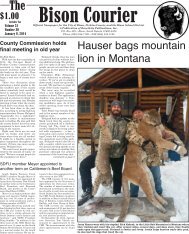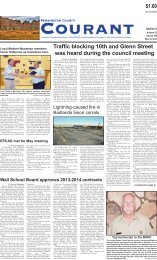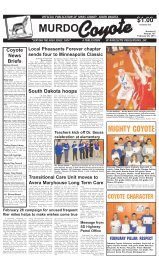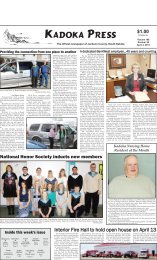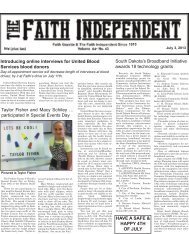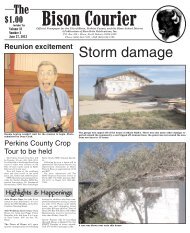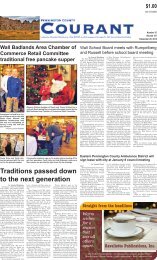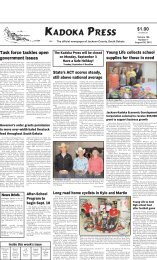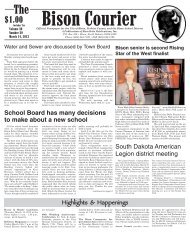E-Coyote_10-11-12_Layout 1.pdf - Pioneer Review
E-Coyote_10-11-12_Layout 1.pdf - Pioneer Review
E-Coyote_10-11-12_Layout 1.pdf - Pioneer Review
Create successful ePaper yourself
Turn your PDF publications into a flip-book with our unique Google optimized e-Paper software.
Murdo <strong>Coyote</strong><br />
Murdo <strong>Coyote</strong> • October <strong>11</strong>, 20<strong>12</strong> • Page <strong>11</strong><br />
Local newspapers connect<br />
us with our communities<br />
by U.S. Rep. Mike Rogers<br />
We can get our national news on<br />
cable television, catch the weather<br />
on local broadcast stations, listen to<br />
talk radio on the AM or FM dial and<br />
follow our favorite blogs on the<br />
Internet, but where do we turn for<br />
local information that directly<br />
impacts our daily lives? More often<br />
than not it is community newspapers.<br />
Technology has transformed how<br />
we gather information in the 21st<br />
Century. Newscycles run 24/7,<br />
tablets and laptops are becoming<br />
smaller and smart phones keep getting<br />
smarter.<br />
As a result most traditional large<br />
newspapers are struggling to stay<br />
alive – they are more and more frequently<br />
printing only two to three<br />
times a week, personnel and content<br />
are shrinking like never before, and<br />
more information is shifted to online<br />
editions.<br />
Yet local community newspapers<br />
are thriving because they have persistently<br />
weathered the storm year<br />
in and year out to remain a fixture in<br />
our everyday lives. As our societies<br />
become more complex and diverse<br />
with growing numbers of ways to<br />
obtain information, the role of local<br />
newspapers in informing our communities<br />
becomes even more significant.<br />
We count on them to regularly<br />
check in with the courts and police<br />
stations. They print announcements<br />
on births, deaths, engagements,<br />
marriages, anniversaries, church<br />
news, job openings, school information<br />
and service club endeavors.<br />
They publish notices of local<br />
municipal meetings. They print tax<br />
South Dakota pastures now<br />
insurable with rainfall index<br />
Pasture, rangeland and forage<br />
(PRF) insurance is available for<br />
2013 in South Dakota based on a<br />
Rainfall Index (RI). Haying and<br />
grazing needs can be covered against<br />
moisture shortages using PRF-RI,<br />
says Matthew Diersen, SDSU<br />
Extension Risk & Business Management<br />
Specialist.<br />
“While producers would prefer to<br />
be paid if they did not have forage,<br />
PRF-RI relies on a close historical<br />
relationship between rainfall timing<br />
and forage production amounts,”<br />
Diersen said.<br />
He explains that producers can<br />
guard against low precipitation during<br />
insured intervals for localized<br />
grids specific to haying or grazing<br />
needs. Rainfall is grid-level and not<br />
farm- or ranch-level when measured.<br />
November 15, 20<strong>12</strong>, is the deadline<br />
to purchase or change coverage<br />
for the 2013 calendar year.<br />
Diersen explains that the PRF-RI<br />
coverage available in South Dakota<br />
mirrors pasture rents (per acre) for<br />
grazing.<br />
“The coverage is constant at<br />
$204.23 per acre for haying. In the<br />
event that precipitation is low during<br />
an insured interval, producers<br />
could use indemnity payments to<br />
replace income or to purchase<br />
replacement feed,” he said. “Unfortunately<br />
the coverage does not<br />
increase should prices move higher<br />
during the insured year.”<br />
Encouraging indicators at the<br />
state level suggest that PRF-RI<br />
would work well to manage forage<br />
production risk. In years with belowaverage<br />
rainfall in South Dakota the<br />
hay yield was also often below-average.<br />
In particular, notable drought<br />
years in South Dakota (1976, 1988,<br />
2002 and 2006) had sharply lower<br />
rainfall totals and hay yields.<br />
According to the Census of Agriculture<br />
there were 23 million acres<br />
in permanent pasture and rangeland<br />
increases, millage initiatives, notices<br />
of changes in laws and property<br />
rezoning – all issues that most<br />
directly affect our pocketbooks by<br />
determining how our hard-earned<br />
tax dollars are spent at the local<br />
level and how are local officials are<br />
representing us.<br />
They help run the local economic<br />
engine and provide a marketplace<br />
for the community. They offer local<br />
small businesses with an effective<br />
and affordable means of connecting<br />
with local consumers. They print<br />
sales at the supermarket, coupons<br />
for discounts at local stores, real<br />
estate listings, and classifieds for<br />
everything from a used car to a<br />
neighbor’s garage sale.<br />
It’s also personal. Communities<br />
feel a sense of ownership in their<br />
local newspaper, and the people that<br />
report the news are often our friends<br />
and neighbors down the street.<br />
News aggregating websites such<br />
as Drudge Report and the major<br />
news blogs are great at offering up<br />
major national and international<br />
news and analysis, but they simply<br />
do not provide the information on<br />
issues that impact us at the local<br />
level. It is especially true for the elderly<br />
and those with low incomes who<br />
often have less access to computers<br />
and transportation.<br />
They normally only publish once<br />
a week, but community newspapers<br />
remain the one constant source of<br />
local information. In good times and<br />
in bad, they stay focused on us as a<br />
community.<br />
Now more than ever, community<br />
newspapers are an important binding<br />
thread of our cities and towns.<br />
across South Dakota in 2007. PRF<br />
has been available in South Dakota<br />
since the 2007 crop year using a vegetation<br />
index, but only 540,000 acres<br />
were insured with PRF in 20<strong>12</strong>.<br />
“As detailed in the crop insurance<br />
provisions, catastrophic coverage is<br />
not available for PRF. Thus, producers<br />
may also purchase Noninsured<br />
Disaster Assistance Program (NAP)<br />
coverage for the pasture, rangeland,<br />
and non-alfalfa hayland,” Diersen<br />
said.<br />
He says it is up to producers to<br />
decide whether the insurance is necessary<br />
and valuable.<br />
“The high subsidy rate likely<br />
gives the coverage value, but there<br />
are no absolute guarantees that precipitation<br />
shortages will always line<br />
up with forage needs,” he said.<br />
Premiums for PRF-RI vary by<br />
county, type, coverage level, practice/interval,<br />
and grid location. Producers<br />
have to pick a coverage level<br />
from 70 to 90 percent of the grid<br />
base. A default to consider would be<br />
the 70 percent level as it has the<br />
highest subsidy rate. Producers also<br />
have to pick a productivity level<br />
from 60 percent to 150 percent of the<br />
county base. This allows for intracounty<br />
variability in soil type, grade,<br />
and forage type.<br />
Diersen explains that there are<br />
many ways to allocate coverage.<br />
“Not all acres need to be insured.<br />
Selected acres are allocated across<br />
<strong>11</strong> two-month intervals. Intervals<br />
cannot overlap a given month. At<br />
most 70 percent and no fewer than<br />
<strong>10</strong> percent of acres can be in a single<br />
interval,” he said. “Ideally, a producer<br />
will know key months that a lack<br />
of precipitation would result in less<br />
forage production.”<br />
For more information, visit<br />
www.igrow.org. Interested insurable<br />
parties can also contact a crop insurance<br />
agent or go on-line to the RMA<br />
website www.rma.usda. gov.<br />
Rutz appointed head of state<br />
Emergency Medical Services<br />
Marilyn Rutz of Belle Fourche<br />
has been appointed Director of the<br />
State Office of Emergency Medical<br />
Services, replacing Danny Hayes,<br />
who retired.<br />
Public Safety Secretary Trevor<br />
Jones announced the appointment<br />
on Friday. Rutz has been serving<br />
in the position since late September.<br />
“Marilyn has the education,<br />
training and experience to be a<br />
great fit in the EMS office,’’ Jones<br />
said. “She is committed to the public<br />
safety of South Dakota citizens<br />
and will be a strong advocate for<br />
programs that continue to improve<br />
the quality of the training and<br />
equipment of the men and woman<br />
who provide emergency medical<br />
services.’’<br />
Rutz has been an emergency<br />
medical technician since 1999 and<br />
a Paramedic since 2002. She<br />
worked for the Butte County<br />
Buy chance on 80 acres<br />
to support S.D. soldiers<br />
Five hundred ticket holders will<br />
be in a drawing to win approximately<br />
80 acres of prime hunting<br />
ground in east-central South<br />
Dakota this month in a raffle to<br />
benefit soldiers of the <strong>11</strong>4th Fighter<br />
Wing Security Force<br />
Squadronof the South Dakota Air<br />
National Guard.<br />
The drawing is part of a<br />
fundraising opportunity to send<br />
the members of this guard unit<br />
and their families on a deep-sea<br />
fishing adventure in Alaska when<br />
they return from their most recent<br />
deployment in support of Operation<br />
Enduring Freedom.<br />
The raffle and trip are part of a<br />
donation from Preventive Health<br />
Strategies to “help restore the<br />
bond between soldiers and families<br />
after their long absence.”<br />
“For returning veterans to successfully<br />
adjust to their home lives<br />
Breast cancer awareness month<br />
by Rep. Kristi Noem<br />
Like all South Dakota moms, I<br />
have loved watching my children<br />
grow and cannot wait to see the<br />
careers they go into, the spouses<br />
they choose and the children they<br />
will have. I want to be around for<br />
all of life’s little milestones, and<br />
breast cancer awareness is a big<br />
part of that. Breast cancer is one of<br />
the leading causes of cancer death<br />
among women, and research<br />
shows that one in eight women<br />
will be diagnosed with breast cancer<br />
at some time during her life.<br />
The good news is there have<br />
been advances in research, technology<br />
and early detection over the<br />
years that have helped decrease<br />
the number of breast cancer related<br />
deaths. But there is much more<br />
work to be done. October is breast<br />
cancer awareness month and it’s a<br />
great opportunity to help spread<br />
the word.<br />
I was in Sioux Falls recently to<br />
Ambulance Service, Lead-Deadwood<br />
Regional Hospital Ambulance,<br />
Lead-Deadwood Regional<br />
Medical Clinic and Mountain<br />
Plains Health Consortium before<br />
joining the State EMS office in<br />
June of 20<strong>10</strong> as an Emergency<br />
Medical Specialist. She is married<br />
with two adult children.<br />
“One of my primary goals is to<br />
support and strengthen ambulance<br />
services and EMTs in South<br />
Dakota,’’ Rutz said. “I look forward<br />
to the challenges ahead. I recognize<br />
that a large majority of<br />
responders are volunteers, and I<br />
welcome comments and suggestions<br />
on ways the Office of Emergency<br />
Medical Services can help<br />
those dedicated men and women<br />
do their jobs.’’<br />
Hayes retired in June. Emergency<br />
Medical Services is an<br />
agency within the Department of<br />
Public Safety.<br />
after a deployment, the whole family<br />
needs time to readjust,” said<br />
Dr. Annette Bosworth of Preventive<br />
Health Strategies in Sioux<br />
Falls.<br />
“Our returning vets need time,<br />
in a restorative environment, to<br />
reconnect with their families - to<br />
make the family unit whole again<br />
after it has been disrupted by the<br />
drama and difficulty of deployment.”<br />
To support the soldiers of the<br />
<strong>11</strong>4th and purchase one or more<br />
raffle tickets, contact Preventive<br />
Health Strategies at 605-368-<br />
1741.<br />
All proceeds from the land raffle<br />
will go to support the Alaskan fishing<br />
adventure.<br />
For more information, to see<br />
photos of the land or to purchase<br />
tickets online, go to the event website<br />
at www.imgivingawaythefarm.com.<br />
participate in the South Dakota<br />
Susan G. Komen Race for the<br />
Cure. In all, over 6,000 participants,<br />
spectators and supporters<br />
came out for the race. It’s always<br />
good when funds stay close to<br />
home, and I was happy to learn<br />
that seventy-five percent of funds<br />
raised in South Dakota stay in<br />
South Dakota, while the other 25<br />
percent go toward national<br />
research.<br />
I encourage all South Dakotans<br />
to recognize this month and put an<br />
extra effort into spreading the<br />
word about breast cancer. If possible,<br />
consider participating in or<br />
volunteering for a Komen event, or<br />
help spread the word through<br />
social media or simply by talking<br />
with family, friends and colleagues.<br />
If you want to know more about<br />
how you can get involved in South<br />
Dakota, visit: http://www.komensouthdakota.org/.<br />
Thune on pheasant season<br />
by Senator John Thune<br />
The annual hunting population<br />
boom will soon be upon us as<br />
friends, family, and visitors make<br />
their way to the fields in search of<br />
our state bird, the Chinese ringnecked<br />
pheasant. In parts of South<br />
Dakota, more people will return<br />
for the pheasant opener than holidays<br />
and it can be hard to get a<br />
seat on an airplane filled with<br />
camouflage bird-seekers. As we dig<br />
out our orange hunting gear and<br />
clean our shotguns, we prepare for<br />
one of the great traditions of our<br />
state.<br />
As a member of the U.S. Senate<br />
Agriculture Committee, I have an<br />
opportunity to shape and support<br />
conservation programs that boost<br />
wildlife habitat and benefit our<br />
hunting traditions in South Dakota.<br />
During debate of the Senate<br />
Farm Bill, I worked to consolidate<br />
23 conservation programs into 13,<br />
while reauthorizing the Conservation<br />
Reserve Program (CRP), a<br />
program of great benefit to our<br />
state’s pheasant population.<br />
Pheasant hunting generates<br />
approximately $200 million in revenues<br />
for South Dakota. Whether<br />
it is the licenses, gas, and gear<br />
that they buy, or the nights spent<br />
in lodges and hotels throughout<br />
the state, it is clear that hunting<br />
in South Dakota is also big business.<br />
But as a kid growing up in<br />
Murdo, we didn’t think of hunting<br />
as a business. For me and many<br />
other kids across the state, hunting<br />
is a way to learn responsibility<br />
and spend time outdoors. This<br />
year will be no different as sons<br />
and daughters across South Dakota<br />
walk the fields, shotguns in<br />
hand, looking to bag their limit.<br />
Hunting season in South Dakota<br />
is my favorite time of year and I<br />
can think of no place I would<br />
rather be than in a field with family<br />
and friends by my side. I wish<br />
all hunters a safe and successful<br />
hunting season.<br />
Call the Murdo <strong>Coyote</strong> to<br />
place your ad here 669-2271



